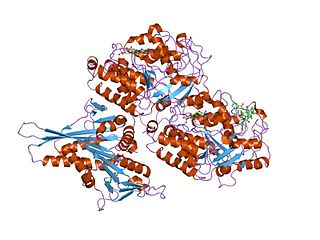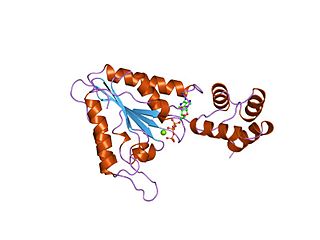Related Research Articles

Microtubules are polymers of tubulin that form part of the cytoskeleton and provide structure and shape to eukaryotic cells. Microtubules can be as long as 50 micrometres, as wide as 23 to 27 nm and have an inner diameter between 11 and 15 nm. They are formed by the polymerization of a dimer of two globular proteins, alpha and beta tubulin into protofilaments that can then associate laterally to form a hollow tube, the microtubule. The most common form of a microtubule consists of 13 protofilaments in the tubular arrangement.

In cell biology, the spindle apparatus is the cytoskeletal structure of eukaryotic cells that forms during cell division to separate sister chromatids between daughter cells. It is referred to as the mitotic spindle during mitosis, a process that produces genetically identical daughter cells, or the meiotic spindle during meiosis, a process that produces gametes with half the number of chromosomes of the parent cell.

Telophase is the final stage in both meiosis and mitosis in a eukaryotic cell. During telophase, the effects of prophase and prometaphase are reversed. As chromosomes reach the cell poles, a nuclear envelope is re-assembled around each set of chromatids, the nucleoli reappear, and chromosomes begin to decondense back into the expanded chromatin that is present during interphase. The mitotic spindle is disassembled and remaining spindle microtubules are depolymerized. Telophase accounts for approximately 2% of the cell cycle's duration.
The microtubule-organizing center (MTOC) is a structure found in eukaryotic cells from which microtubules emerge. MTOCs have two main functions: the organization of eukaryotic flagella and cilia and the organization of the mitotic and meiotic spindle apparatus, which separate the chromosomes during cell division. The MTOC is a major site of microtubule nucleation and can be visualized in cells by immunohistochemical detection of γ-tubulin. The morphological characteristics of MTOCs vary between the different phyla and kingdoms. In animals, the two most important types of MTOCs are 1) the basal bodies associated with cilia and flagella and 2) the centrosome associated with spindle formation.

Tubulin in molecular biology can refer either to the tubulin protein superfamily of globular proteins, or one of the member proteins of that superfamily. α- and β-tubulins polymerize into microtubules, a major component of the eukaryotic cytoskeleton. Microtubules function in many essential cellular processes, including mitosis. Tubulin-binding drugs kill cancerous cells by inhibiting microtubule dynamics, which are required for DNA segregation and therefore cell division.

Dyneins are a family of cytoskeletal motor proteins that move along microtubules in cells. They convert the chemical energy stored in ATP to mechanical work. Dynein transports various cellular cargos, provides forces and displacements important in mitosis, and drives the beat of eukaryotic cilia and flagella. All of these functions rely on dynein's ability to move towards the minus-end of the microtubules, known as retrograde transport; thus, they are called "minus-end directed motors". In contrast, most kinesin motor proteins move toward the microtubules' plus-end, in what is called anterograde transport.

AAA proteins or ATPases Associated with diverse cellular Activities are a protein family sharing a common conserved module of approximately 230 amino acid residues. This is a large, functionally diverse protein family belonging to the AAA+ protein superfamily of ring-shaped P-loop NTPases, which exert their activity through the energy-dependent remodeling or translocation of macromolecules.
In cell biology, microtubule-associated proteins (MAPs) are proteins that interact with the microtubules of the cellular cytoskeleton. MAPs are integral to the stability of the cell and its internal structures and the transport of components within the cell.

Stathmin, also known as metablastin and oncoprotein 18 is a protein that in humans is encoded by the STMN1 gene.

Aurora kinase A also known as serine/threonine-protein kinase 6 is an enzyme that in humans is encoded by the AURKA gene.
In cell biology, microtubule nucleation is the event that initiates de novo formation of microtubules (MTs). These filaments of the cytoskeleton typically form through polymerization of α- and β-tubulin dimers, the basic building blocks of the microtubule, which initially interact to nucleate a seed from which the filament elongates.
Polo-like kinases (Plks) are regulatory serine/threonin kinases of the cell cycle involved in mitotic entry, mitotic exit, spindle formation, cytokinesis, and meiosis. Only one Plk is found in the genomes of the fly Drosophila melanogaster (Polo), budding yeast (Cdc5) and fission yeast (Plo1). Vertebrates and other animals, however, have many Plk family members including Plk1, Plk2/Snk, Plk3/Prk/FnK, Plk4/Sak and Plk5. Of the vertebrate Plk family members, the mammalian Plk1 has been most extensively studied. During mitosis and cytokinesis, Plks associate with several structures including the centrosome, kinetochores, and the central spindle.
In enzymology, a microtubule-severing ATPase (EC 3.6.4.3) is an enzyme that catalyzes the chemical reaction

Katanin p80 WD40-containing subunit B1 is a protein that in humans is encoded by the KATNB1 gene.

Katanin p60 ATPase-containing subunit A1 is an enzyme that in humans is encoded by the KATNA1 gene.

Kinesin-like protein KIF1A, also known as axonal transporter of synaptic vesicles or microtubule-based motor KIF1A, is a protein that in humans is encoded by the KIF1A gene.

Kinesin-like protein KIF11 is a molecular motor protein that is essential in mitosis. In humans it is coded for by the gene KIF11. Kinesin-like protein KIF11 is a member of the kinesin superfamily, which are nanomotors that move along microtubule tracks in the cell. Named from studies in the early days of discovery, it is also known as Kinesin-5, or as BimC, Eg5 or N-2, based on the founding members of this kinesin family.

Kinesin family member 15 is a protein that in humans is encoded by the KIF15 gene.
The XMAP215/Dis1 family is a highly conserved group of microtubule-associated proteins (MAPs) in eukaryotic organisms. These proteins are unique MAPs because they primarily interact with the growing-end (plus-end) of microtubules. This special property classifies this protein family as plus-end tracking proteins (+TIPs).

Neurotubules are microtubules found in neurons in nervous tissues. Along with neurofilaments and microfilaments, they form the cytoskeleton of neurons. Neurotubules are undivided hollow cylinders that are made up of tubulin protein polymers and arrays parallel to the plasma membrane in neurons. Neurotubules have an outer diameter of about 23 nm and an inner diameter, also known as the central core, of about 12 nm. The wall of the neurotubules is about 5 nm in width. There is a non-opaque clear zone surrounding the neurotubule and it is about 40 nm in diameter. Like microtubules, neurotubules are greatly dynamic and the length of them can be adjusted by polymerization and depolymerization of tubulin.
References
- ↑ "McNally, F. & Vale, R. (1993) Identification of katanin, an ATPase that severs and disassembles stable microtubules" (PDF). Archived from the original (PDF) on 2006-09-03. Retrieved 2006-02-18.
- ↑ Downing, K. & Nogales, E. (1998). Tubulin and microtubule structure. [ permanent dead link ]
- ↑ Hartman, J. & Vale, R. (1999) Microtubule Disassembly by ATP-dependent Oligomerization of the AAA Enzyme Katanin
- ↑ Ahmad, F., Yu, W., McNally, F. & Baas, P. An Essential Role for Katanin in Severing Microtubules in the Neuron
- 1 2 McNally, F. & Thomas, S. (1998) Katanin Is Responsible for the M-Phase Microtubule severing Activity in Xenopus Eggs
- 1 2 "Quarmby, L. (2000) Cellular Samurai: katanin and the severing of microtubules" (PDF). Archived from the original (PDF) on 2005-01-16. Retrieved 2006-02-18.
- ↑ Srayko, M., Buster, W., Bazirgan, O., McNally & F., Mains, P. (2000) MEI-1/MEI-2 Katanin-like Microtubule Severing Activity is Required for Caenorhabditis elegans Meiosis.
- ↑ Karabay, A., Yu, W., Solowska, J., Baird, D. & Baas, P. Axonal Growth is Sensitive to Levels of Katanin, a Protein that Severs Microtubules.
- ↑ Dent, E., Callaway, J., Gyorgyi, S., Baas, P. & Kalil, K. (1999) Reorganization and Movement of Microtubules in Axonal Growth Cones and Developing Interstitial Branches.
- ↑ Waterman-Storer, C. & Salmon, E. (1997). Actomyosin-based retrograde flow of microtubules in the lamella of migrating epithelial cells influences microtubule dynamic instability and turnover and is associated with microtubule breakage and treadmilling.
- ↑ Burk, D. & Ye, Z. (2002) Alteration of Oriented Deposition of Cellulose Microfibrils by Mutation of a Katanin-Like Microtubule-Severing Protein.
- ↑ Yu, W.; Solowska, J.; Qiang, L.; Karabay, A.; Baird, D.; Bass, P. (2005). "Regulation of Microtubule Severing by Katanin Subunits during Neuronal Development". Journal of Neuroscience. 25 (23): 5573–5583. doi:10.1523/JNEUROSCI.0834-05.2005. PMC 1201504 . PMID 15944385.
- ↑ "Baas, P.W., Karabay, A. & Qiang, L. (2005). Microtubules Cut and Run" (PDF). Archived from the original (PDF) on 2006-09-14. Retrieved 2007-05-26.
- ↑ Cyr, R.J. & Palevitz, B.A. (1995) Organization of cortical microtubules in plant cells.
- ↑ Mellet, V.; Gaillard, J.; Vantard, M. (2003). "Plant Katanin, a microtubule severing protein". Cell Biology International. 27 (3): 279. doi:10.1016/s1065-6995(02)00324-4. PMID 12681335. S2CID 36263251.
- ↑ Mellet, V.; Gaillard, J.; Vantard, M. (2002). "Functional evidence for in vitro microtubule severing by the plant katanin homologue". Biochemical Journal. 365 (Pt 2): 337–342. doi:10.1042/bj20020689. PMC 1222700 . PMID 12020351.